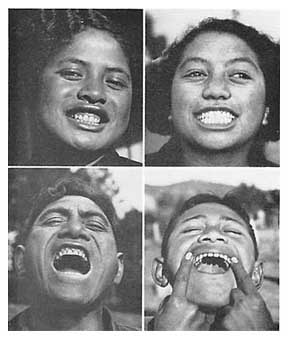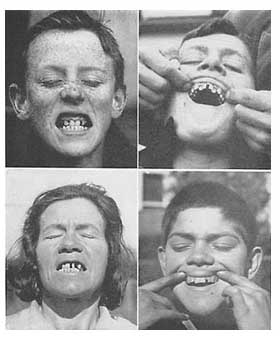The post What Is The Paleo Diet? appeared first on Food Compass.
]]>
Photo by Dr Price American Dental Association. Healthy Maori teeth before introduction of European diet. Few cavities straight teeth good arches.
Homo Sapiens, yes that’s you, have been around a long time.
Millions of years in fact, but up until only about 10,000 years ago we were still running around with spears, hunting and foraging for our food. We’ve come along way in the last 10,000 years, and it’s not all good.
We’ve changed how we live and how we eat, and our genes are struggling to catch up.
Turns out that diseases that are common in modern civilisation like cancer, diabetes and cardiovascular disease were not so common in our pre-agricultural ancestors. Not only were they healthier, they were taller, stronger and had good dental health.
A Paleo style diet is looking to the past to help improve our future health, adopting a diet our genes evolved to eat, not a diet based on cheap, high calorie, low nutrient, processed foods.
So how do we go back to a more natural way of eating?
In a nutshell a Paleo style diet includes lots of vegetables, good quality meat, fish, fruit, nuts and seeds. Excluding grains, refined sugars and industrial seed oils remove the culprits responsible for many of our modern health issues.
So what’s wrong with these foods? Isn’t bread the staff of life?
Grains are by far the biggest change when adopting a Paleo approach to eating. From our morning cereal, to our lunchtime sandwich, to our pasta dinner, we rely heavily on grains in our diet.

Taken at the same time as photos above. European diet of processed foods, white flour, sugar and refined oils and affect of teeth, and bone structure.
But grains were never a big part of our diet prior to the agricultural revolution and our bodies are simply not adapted to digesting them without the risk of gut damage. They contain lectins, phytonutrients, not to mention the protein gluten.
Modern wheat has also changed a lot from earlier varieties. Changes made to wheat around the 1960s to produce a higher yield have also resulted in wheat with less nutrients and higher levels of gluten.
The reality is that grains are just not that nutritious. Breads and cereals are commonly fortified with vitamins and minerals to improve their nutritional value. Replacing these foods with vegetables, meat and fruit drastically increases the nutrients in our diet, leading to improved health.
You also won’t find legumes, dairy, refined sugar and industrial vegetable oils in a Paleo kitchen.
What about legumes?
Legumes for a similar reason to grains, while they are certainly more nutritious than grains, they still have and lectins that can cause gut problems.
Not dairy too?
Dairy can cause problems with people that are lactose intolerant and/or casein intolerant although some with ancestors that were herders have developed the ability to continue to process lactose past childhood.
What’s the deal with vegetable oils?
Seeds and vegetable oils like soybean and canola oils are high in omega 6s. We need to consume Omega 6 and Omega 3 in a certain balance for optimum health and our modern diet throws that balance way off and leads to inflammation in the body. While anthropolicical evidence suggests a healthy ratio of Omega 6 to Omega 3 is approximately 1:1. Most modern diets deliver a ratio closer to 16:1! Switching to healthier fats can help restore the balance and reduce inflammatory conditions.
What is the Paleo Diet….and what it isn’t.
The Paleo diet is not a weight loss diet, although weight loss is common if people have excess weight to lose.
It is not a low carb diet by default. Including fruit, starchy carbohydrates and white rice as many people choose to do can increase the carb levels to the individuals needs.
The Paleo Diet is more of a template or a lifestyle choice of eating foods that match the evolution of our digestive system.
While there are basic ideas and guidelines it is up to the individual whether they follow the guidelines strictly, adopt an 80/20 approach, have a weekly non-paleo day or include dairy, rice and gluten-free grains. There is no right or wrong, you won’t be kicked out of the club if you don’t “do” it properly.
If the ideas and available science resonate with you, then all you can do it try it for yourself.
The post What Is The Paleo Diet? appeared first on Food Compass.
]]>